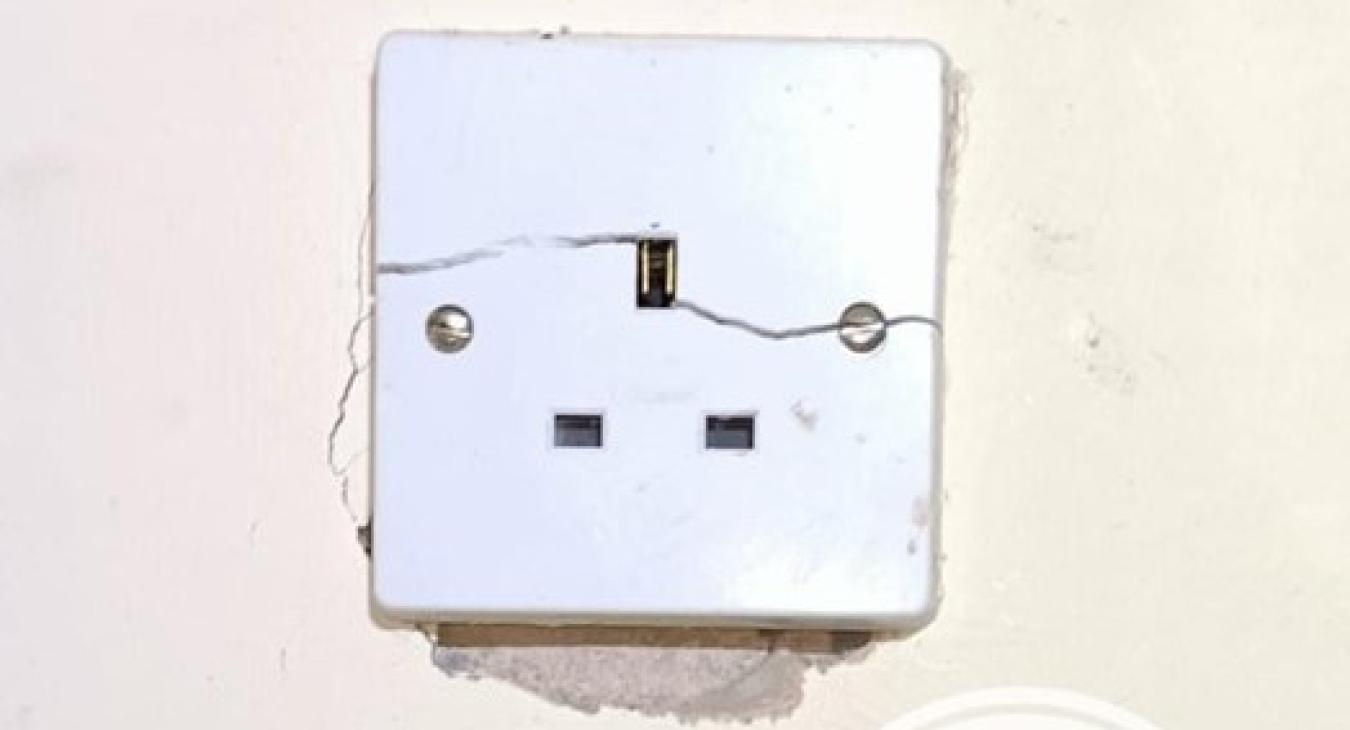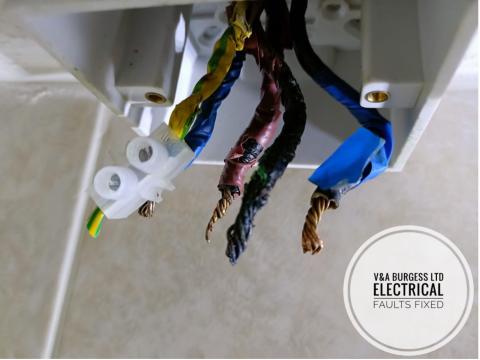
1) Cracked Plug Socket?
Having a cracked plug socket is an indication that things are not right. Once a plug socket becomes cracked it is no longer safe. It has deviated beyond the manufacturers safe operating intentions and now must be replaced.
There are a number of reasons why a plug socket may become cracked such as:
- Overtightening the screws
- Mechanical Impact Damage
- Overheating through too many appliances
- Overheating due to loose connections
- Aging Plug Socket Dirt and Debris
2) Overtightening the Screws
Every socket or power outlet is held in place by at least two 3.5mm machine screws to ensure that there is no access to live parts and thereby minimising the risk of electric shock. The screws locate into two lugs in an electrical box at the rear of the plug socket.
This wall plug socket is easily overtightened and as such is liable to crack across the face of the plug socket in the event of overtightening. A qualified electrician will take great care when installing a wall socket to make sure that the screws are adequately tightened in order to secure it but not so much as to cause electric outlets to become cracked or otherwise damaged.
Back to top3) Mechanical Impact Damage
Where power sockets are installed in the property, care must be taken to ensure that they come to no harm. Nevertheless, there are instances where a wall socket can become damaged by passing traffic, activities occurring in the area of installation or accidental impact damage.
When this type of damage occurs, it is vitally important for electrical safety to have the broken outlets replaced as soon as possible with new sockets or a cover plate or blanking plate installed. Once plug sockets have become damaged there is a risk of electrical fire, power failures, short circuit, or electric shock. The socket will no longer function as the manufacturer intended and a further impact is likely to increase the danger.
Back to top4) Overheating through too many appliances
When an excessive power demand is placed upon a socket outlet the electrical system may not cope and the wall socket is likely to overheat leading to electrical failure and possibly electrical fire.
Nearly every UK plug socket is rated to a maximum load of 13 amps of electrical current. This means that two typical power kitchen appliances would likely overload a double socket if used at the same time. Electrical wire will become overheated in the rear of the socket leading to electrical faults, excessive heat, a burnt plug of the appliance or even electric fire!
Where these situations occur, it is important to note that a circuit breaker in the consumer unit or fuse wire in the fuse board is unlikely to trip or blow. Electrical systems are designed and installed to minimise the risk of overload, electric shock, and electrical faults but there are situations where constant use, a faulty electrical appliance, loose wires, poor electrical work, overloading, and other issues can result in risk of fire in electrical fire without the protection offered by the consumer unit or fuse box.
Back to top5) Overheating due to loose connections
The way in which our power supply works is through an alternating current. That is, the electrical current alternates between a positive and negative state and cycles at the rate of 50 times per second UK and 60 times per second USA. This gives a very tiny vibration on the cables due to the ever-changing state.
The cables are usually made from copper, the terminals of electrical equipment usually made from brass or steel. This gives two further issues. One is that of expansion and contraction due to metal construction as electrical systems warm up and cool down. The second is the different rates at which different metals expand and contract dependant upon the metal from which they are fabricated.
When we combine these factors together, over time, electrical connections can become loose. This assumes that the installation was carried out correctly in the first place of course. Poor wiring installation can lead to electrical problems much sooner and increase the risk of fire.
Poor connections are responsible for around 30% of our emergency callouts I would say.
An old plug could also be the cause of poor connections as internal connections on plug tops are rarely checked EVER. This leads to an increase in heat which can transfer to the socket face causing it to crack.
Back to top6) Aging Plug Socket, Dirt and Debris
When plug sockets and other electrical accessories are subject to general use over the years, they can suffer from worn internal metal moving parts. These metal contact points then don’t quite make a connection that is as electrically sound as needed. This leads to a high resistance and heat build-up!
Once heat starts to build up in electrical systems, the resistance to electrical current flow increases. This itself produces more heat as electrical current struggles to flow leading to even more resistance and before we know it, there is a faulty electrical outlet, scorch marks, damaged electrical wiring and remedial works that need to be carried out.
Dirt and debris can also enter the electrical sockets over time causing barriers to electrical current flow by reducing electrical conductivity of metal parts through dirt coating and corrosion. This leads to our vicious cycle of heat and resistance again.
Back to top7) What are my options?
If you have a cracked plug socket then don’t leave it until there are further problems. Many clients will ignore the problem which can lead to secondary issues like a tripping switch, burnt cables or scorch marks appearing. As a minimum the faulty electrical outlet will just cease to work but heat will continue to build in the wiring behind as the electrical circuit continues to operate and more pressure is placed on a different socket.
The best thing to do is:
- Stop using the outlet immediately if it not in good condition
- Call an electrician to check the outlet, electrical wiring and replace the outlet.
- Have the electrician carry out necessary safety checks whilst replacing the outlet
If you can smell burning:
- Unplug the appliances from the affected plug socket
- Turn the circuit off at your fuse box or consumer unit
- Call an emergency electrician immediately to investigate
8) Common Questions
8.1) What electrical appliances are considered high-powered?
Almost any electrical appliance that gets warm, heats water or cooks food. So, this could be fan heaters, electric ovens, electric showers, washing machines, dryers, dishwashers, kettles, toasters and much more.
Remember that a typical UK plug socket is only rated to 13 amps of electrical current meaning that any two of the above appliances is likely to overload the plug socket immediately without necessarily causing the electrical supply to trip.
8.2) Is it safe to use a cracked plug socket?
No. It is not safe to use a cracked plug socket. As inconvenient as this may be, it must not be used! An electrician should be called to replace the plug socket and investigate why it has cracked in the first place.
8.3) Can an outlet start a fire if nothing is plugged into it?
YES. An outlet can start a fire EVEN IF nothing is plugged in to it. There could be a fault with the outlet itself leading to arcing, sparking, overheating and fire OR there could be an issue with the wiring behind which carries the electricity supply from the outlet to other outlets. Just because the outlet has nothing plugged in does not mean that any issues behind will not cause problems.
If you are experiencing any electrical issues, contact us here Electrical Faults Fixed. We are your experienced electrician in Liverpool and are always on hand to help.
Back to top










